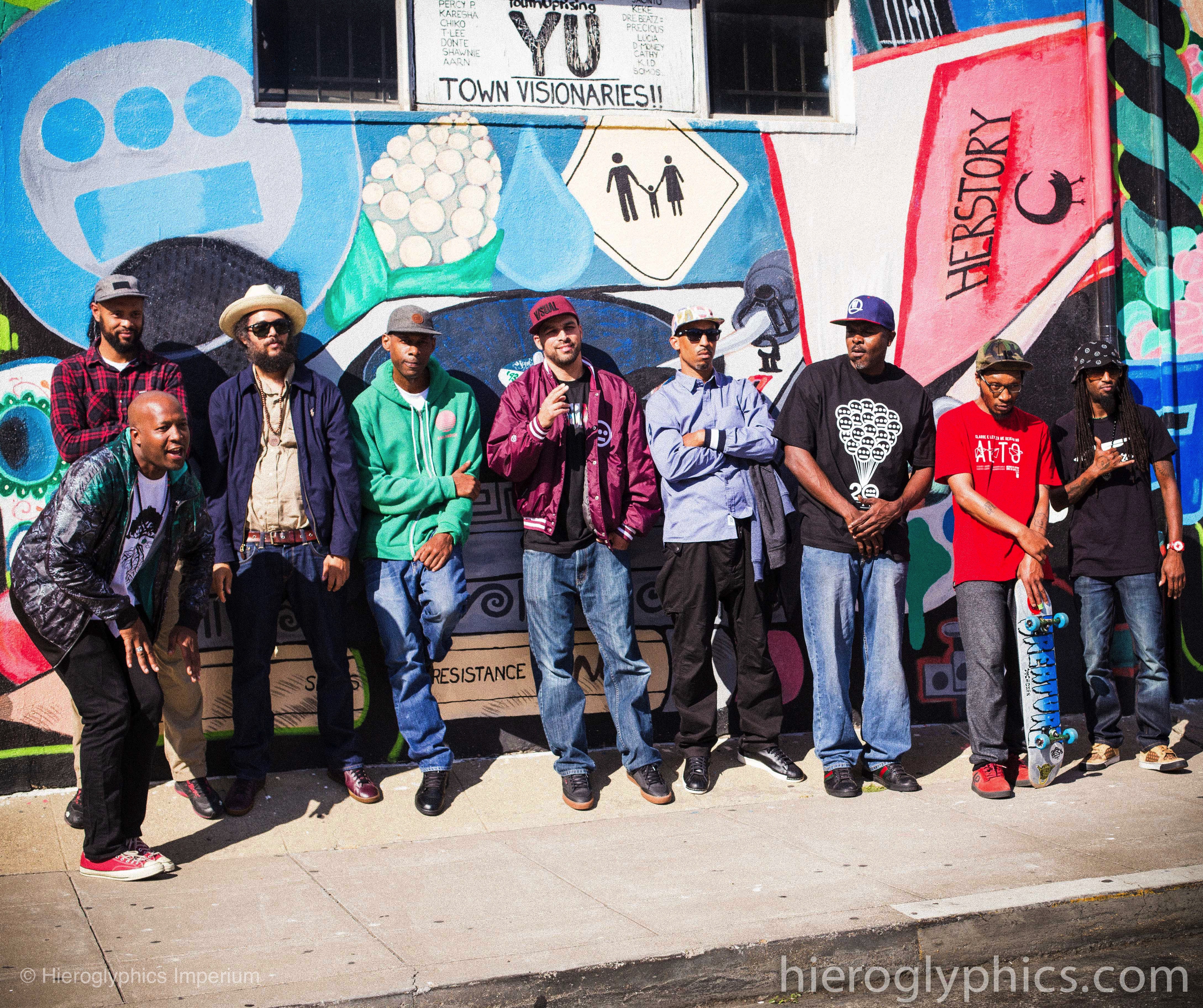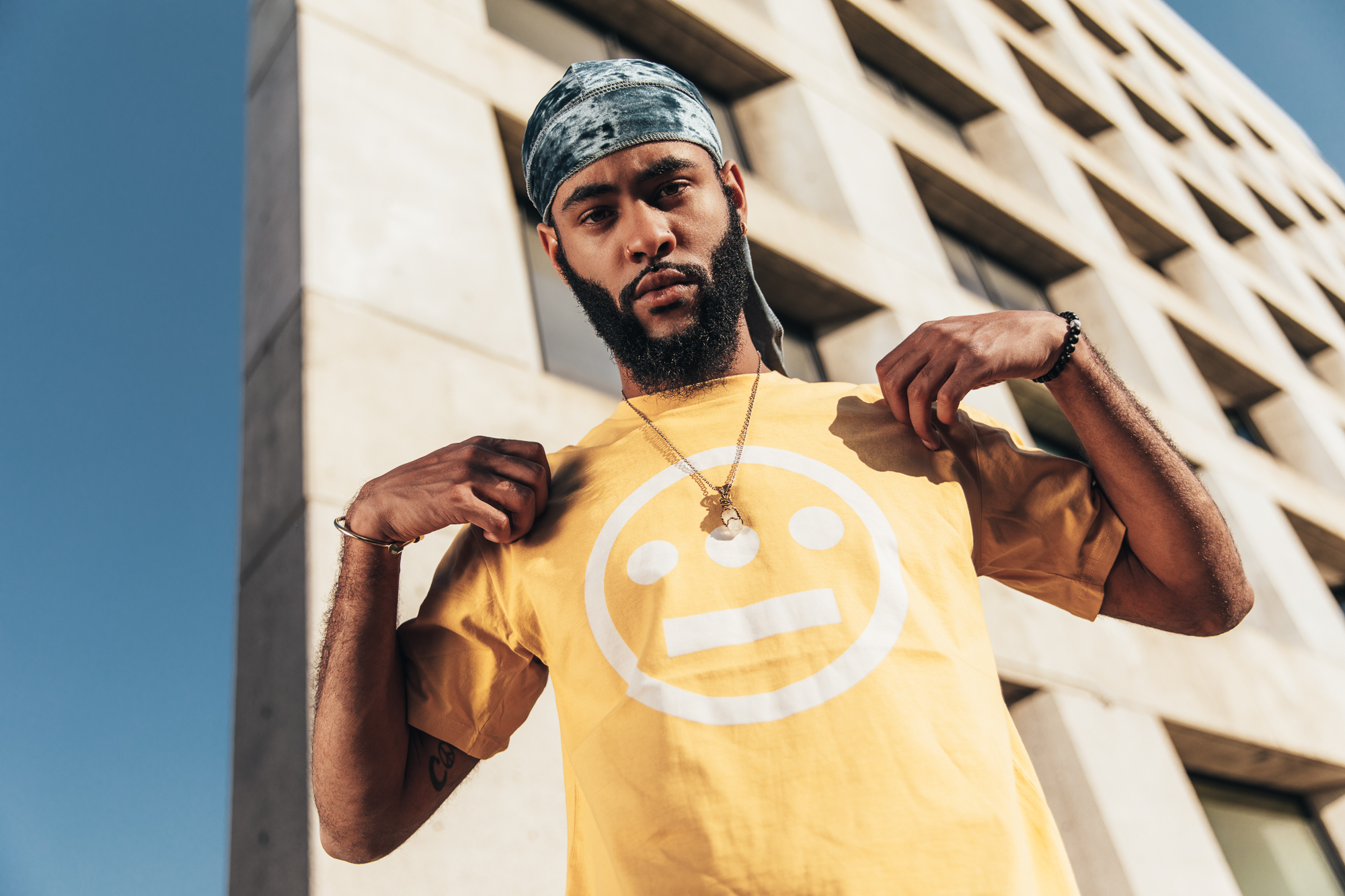If you’ve been anywhere near hip-hop in the past 25 years, you’ve seen the Hieroglyphics logo before. Guaranteed. You know, the deadpanned circular face with three dots for eyes and a straight line for the mouth? Maybe you don’t remember the first time you saw it, because it’s just been everywhere. On a hoodie in the Bay Area. On a hat in New York City. A sticker on a bathroom wall in Chicago or even on a pair of skate shoes in Brazil. It’s global. And it’s come to symbolize much more than the Oakland-based Hieroglyphics crew that it represents. It’s become one of the rare symbols of hip-hop culture and style.
But how did an independent hip-hop crew formed in 1991 develop a ubiquitous logo that’s towered over most other hip-hop iconography since and still keep it fresh in 2020? The answer lies in an unwavering ethos of independence from the nine-member crew and in a fundamental design concept: Keep it simple.
“I was hella into counter-culture. ’60s rock…hippie era sh*t and funk. I was into that cause I was born in the ’70s,” says Del The Funky Homosapien, the eclectic Hieroglyphics MC and the artist behind the logo’s original design. “I wanted something like the yellow smiley face, but the way I drew it, with the third eye in the middle and a line instead of a smile, it indicated that you’re concentrating or something. I’m into graphic design and I wanted something simple like that. I doodled it on a napkin.”
The logo became the mark of the Hieroglyphics (Hiero) crew which also includes the group Souls Of Mischief and appeared on all of their album covers. Between the two groups and their respective solo careers, the entire Hiero Imperium has produced undisputed hip-hop classics like Souls Of Mischief’s “93 ‘til Infinity”, Hiero’s “You Never Knew” and Del’s “Mistadobalina.” A part of the Bay Area hip-hop fabric, Hiero have stayed relevant on their golden age era stature and a steady stream of solo releases from the crew’s members. But above all, it’s the merch component predicated on the Hiero logo that has cemented their stylistic legacy.
In 1992 and 1993, the Plan B Skateboards company’s influential skate videos “Questionable” and “Virtual Reality” featured songs from Del and Souls Of Mischief. The rappers were soundtracking your little brother’s favorite Tony Hawk’s Pro Skater character, Rodney Mullen, flipping tricks that nobody had ever seen before and it flowed so well. Skaters started gravitating to the music and Hiero’s appeal was immediately beginning to transcend hip-hop circles. In short, the logo was gravitational.
“A lot of skaters, headbangers, and punk rockers started getting the tattoo or putting it on their skateboards representing,” says rapper Tajai of Souls Of Mischief. “So then it took on a different cultural significance, almost like a fight club. This counter-culture club where if you know about Hiero, you know and ‘I f*cks witchu.’ Like the masonry or something… And the people getting the tattoos were actually listening to the music, you see what I’m saying?”

Hiero seeped into the underground, where skaters and rap cats who consciously looked away from the mainstream were finding meaning in the logo. It was something that they could don on decks and shirts to simply show that they were looking for style and culture below the surface. And for many, it was an introduction to hip-hop.
Cryptically enough, the crew came to find out that if you remove the circle from the face, the three dots and single line look exactly like the Mayan numeral for eight. Del explained that Souls Of Mischief’s A-Plus showed him a book of ancient hieroglyphs after he created it and that’s when he first noticed it. Tajai says that the Mayan number 8 means “infinity and harmonious resonance” and that these tangential, coincidental meanings just added to the allure of the logo.
The Hiero logo merchandise has flourished non-stop across almost three decades. Shirts, hats, custom skateboards, beanies, lanyards, millions of stickers, men’s clothes, women’s clothes, baby clothes, all emblazoned with the Hiero logo and available in every color combination you can think of. Of course, there’s even a Hiero mask available in the pandemic era. Bay Area sports teams crossover designs, limited edition runs, you name it. It’s become bigger than hip-hop. It’s become a hip-hop lifestyle brand.
“The Rolling Stones logo symbolizes rock, the Black Flag logo symbolizes punk and sh*t, you feel me?” Del says. “It’s definitely one of them types of logos. And I never had an idea that it would be [big] like this.”
“It’s huge. It’s our main thing,” Tajai adds. “It’s the main reason why we have money. Show money? There’s nine of us, you can’t do nine shows a day, but you can sell $1000 of merch every day. It’s become iconic; we’ve got fans worldwide and that’s the thing, kids might not be old enough to go to a show, but they can definitely wear a t-shirt.”
A couple of years ago, in an effort to be able to focus more on their music and less on the day-to-day operations of the merchandise, Hiero partnered with Oaklandish, a civic pride-focused retailer and designer in Oakland. A bastion of Bay Area style themselves, Oaklandish now produces and sells the full-line of Hiero merch.

Previously a vendor at the yearly Hiero Day festival in Oakland since 2014 and making the official shirt of the event, Oaklandish and Hiero shared a distinct history and each had unique footholds in Bay Area culture. Bringing the two Oakland institutions was a natural fit in that regard, and Oaklandish CEO & Creative Director Angela Tsay knew the power of what she was working with.
“There’s certain logos that are so simple and iconic,” Tsay says. “Even as a one-color design, you can immediately recognize them; for a split second in a video or someone walking down the street. That’s what makes the best logos, that instant recognizability and that it means something. You’ve seen it so many times, that it’s become a part of your life.”
Tsay says that Oaklandish has helped Hiero elevate the fabrics, added more custom made cut and sew pieces to the line, and can ship orders out more efficiently. They did a Hiero fleece collection with major performance wear brand Champion and a New Era fitted hat that sold out in 24 hours. They’ll soon be rolling out a colorway of the Hiero fitted hat with new color combos every month for people to match their outfits to and Tajai says that even with a partner in the mix, the sales returns for the Hiero crew have increased.
“Those guys have proven that being independent can work,” Tsay says. “That you can still control your own destiny even in the midst of capitalism, and they’ve stayed true to that.”







